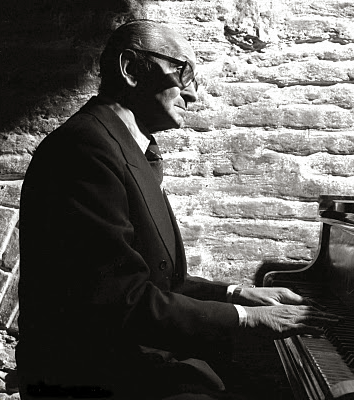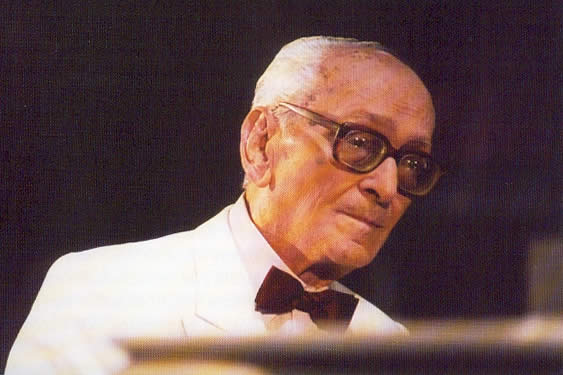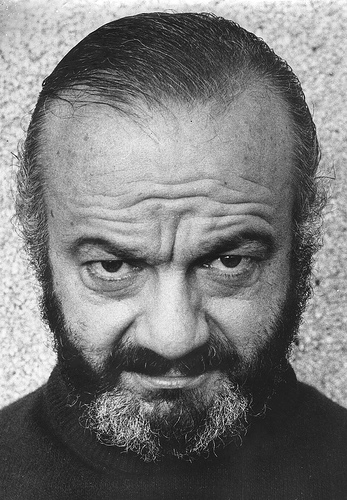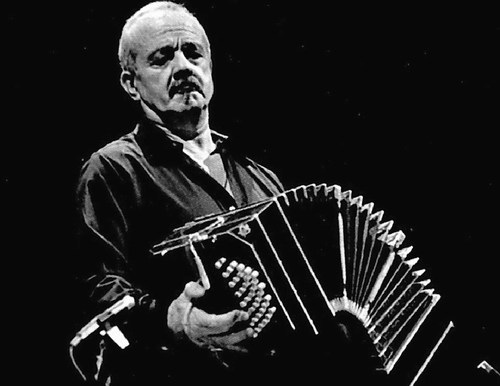<Back to Index>
- Composer and Pianist Osvaldo Piedro Pugliese, 1905
- Composer and Musician Ástor Pantaleón Piazzolla, 1921
PAGE SPONSOR


Osvaldo Pedro Pugliese (Buenos Aires, December 2, 1905 – July 25, 1995) was an Argentine tango musician. He developed dramatic arrangements that retained strong elements of the walking beat of salon tango but also heralded the development of concert - style tango music.
Some of his music, mostly since the 50s, is used for theatrical dance performances. In Buenos Aires, Pugliese is often played later in the evening when the dancers want to dance more slowly, impressionistically and intimately.
Pugliese is a great choice for slower tango dance music, but the arrangements can be a bit more rhythmically challenging than those played by other orchestras. 'Recuerdo' (1924) and 'La yumba' (1946) are two of Pugliese's most popular tangos.
Pugliese was outspoken in his political opinions. His communist sympathies, though never violent, at times earned him the hostility of those in power. Populist President Juan Perón is
said to have had labor union heavies once intimidate Pugliese by
locking him in a sinking boat, rescuing him at the last minute; though
the alleged 1949 incident has never been proven (Pugliese, likewise,
seldom spoke of it publicly), the day President Perón awarded the
great pianist the Order of May (Argentina's highest civilian award), he
embraced Pugliese, saying: "Thank you, maestro, for forgiving".
He was born on December 2 of 1905 in the Buenos Aires neighborhood of Villa Crespo, within a family of musicians, though not as talented as him. His father, Adolfo Pugliese, played the flute in the district assemblies, mainly in quartets. Two of his older brothers, Vicente Salvador and Alberto Roque, were also musicians.
Adolfo, his father helped him make his first "strokes" in music, bought him a violin with which he was sent to the Odeon Conservatory in the neighborhood of Villa Crespo. But there he discovered the instrument that would be part of his life and that he would emphasize, the piano.
He studied with great masters such as Vincent Scaramuzza and Rubione Pedro, and became an extraordinary pianist.
After fifteen years as a trio with the bandoneonist Domingo Faillace and the violinist Alfredo Ferrito with whom he debuted at a neighborhood bar (in Argentina referred to generically as cafes) called Cafe Pig, a name given by the regulars in reference to the poor hygiene of its owner and its location.
Later he would get to the big city, Buenos Aires, where he debuted in a group, along with the country's first female bandoneonist: Francisca Bernardo Cruz, better known as "Paquita", "La Flor de Villa Crespo".
Later, and with much more experience and fluency, he was part of the quartet of Enrique Pollet (1924), and later with another famous orchestra of his time, Roberto Firpo. Already in 1926, he was the pianist of the orchestra of the great bandoneonist Pedro Maffia, continuing his ascent into the world of tango and gaining more and more prestige.
But the dream of Osvaldo Pugliese was to have his own orchestra. He broke off that of Pedro Maffia in 1929, along with violinist Elvino Vardaro, to form his own group. Both played initially at the café Nacional with great success, which resulted in them touring throughout the country. However, the tour was a financial failure and they had to pawn some of their tools to buy return tickets. On his return he joined the orchestra of Alfredo Gobbi, and later accompanied Daniel Hector Alvarez, Roberto Firpo and Miguel Calo.
But Pugliese never abandoned his dream and in 1936 created a sextet with Alfredo Calabro, Juan Abelardo Fernández and Marcos Madrigal (bandoneon), Curzel Rolando and Juan Pedro Potenza (violins), Aniceto Rossi (bass), and director. They debuted in the famous Corrientes Avenue, in the Germinal. This was the starting point of his orchestra. It was presented at the cafe El Nacional on August 11th of 1939. The orchestra would accompany him for 55 years. During that time, Don Osvaldo wrote over 150 songs, some very famous as I remember, The Drink, Negracha, Malandraca and The yumba. They also recorded over 600 songs from other composers.
Pugliese was not only a great pianist, but also a committed citizen. In 1935 he help organize the Argentine Union of Musicians being member number 5. He began, then, a fight "... where the work is personal dignity and not punishing." In 1936 he joined the young Argentine Communist Party (his membership number being 108). This and his ideas caused him to be persecuted, censored and imprisoned during the government of Juan Domingo Peron and then during the de facto government known as the self Liberating Revolution. But during the time of his plight, his orchestra did not stop playing, even deprived of its director.
It was during the decade of the 50 that Pugliese's orchestra encouraged the milongas of Palermo Athletic Club, who was then a stronghold opposition to the official policies of the government.
Pugliese received numerous awards. The government of Cuba awarded him the medal Alejo Carpentier, the most important cultural distinction of the island, the French government appointed him Commandeur de L'Ordre des Arts et Lettres (1988). While his city, the City of Buenos Aires, in 1986, declared him Illustrious Citizen. In1989, the Argentina Society of Authors and Composers (SADAIC) and the Tango Collectors Association, unveiled a plaque in the Corrientes Avenue (at 960) to commemorate 50 years of the teacher in front of his orchestra. In 1990, he received the title of Honorary Academician of the National Academy of Tango.
With his orchestra performed singers like Roberto Chanel, Alberto Morán, Jorge Vidal, Jorge Maciel, Miguel Montero, Alfredo Belusi, Adrian Guida and Abel Córdoba, the latter for 30 years.
Such was the artistic stature of Osvaldo that in 1985 he achieved what no one else had before: on December 26 of that year, to celebrate his 80th birthday, his orchestra would play in the world famous Teatro Colon of Buenos Aires, a place reserved almost exclusively for classical music and opera. Obviously, the theater was packed to watch the teacher perform his works, of 46 years of uninterrupted activity.
Finally, on July 25th of 1995 and after a brief illness, Pugliese died at 89 years of age in the city of Buenos Aires. His remains were veiled in the Legislative Council of the City of Buenos Aires and then taken to the cemetery along the emblematic Avenida Corrientes. There he lies, in an imposing mausoleum built with the contribution of tango lovers in many countries of the world via the work of a Committee of Friends and the perseverance and drive of his wife and life partner Lydia Elman.


Ástor Pantaleón Piazzolla (March 11, 1921 – July 4, 1992) was an Argentine tango composer and bandoneón player. His oeuvre revolutionized the traditional tango into a new style termed nuevo tango, incorporating elements from jazz and classical music. A virtuoso bandoneónist, he regularly performed his own compositions with different ensembles.
Piazzolla was born in Mar del Plata, Argentina, in 1921 to Italian parents, Vicente "Nonino" Piazzolla and Asunta Manetti. His grandfather, a sailor and fisherman named Pantaleone Piazzolla, had immigrated to Mar del Plata from Trani, a seaport town in the southeastern Italian region of Apulia, at the end of the 19th century. Ástor Piazzolla spent most of his childhood with his family in New York City, where he was exposed to both jazz and the music of J.S. Bach at an early age. While there, he acquired fluency in four languages: Spanish, English, French, and Italian. He began to play the bandoneón after his father, nostalgic for his homeland, spotted one in a New York pawn shop. At the age of 13, he met Carlos Gardel, another great figure of tango, who invited the young prodigy to join him on his current tour. Much to his dismay, Piazzolla's father deemed that he was not old enough to go along. While he did play a young paper boy in Gardel's movie El día que me quieras, this early disappointment of being kept from the tour proved to be a blessing in disguise, as it was on this tour that Gardel and his entire band perished in a plane crash. In later years, Piazzolla made light of this near miss, joking that had his father not been so careful, he would not be playing the bandoneón — he would be playing the harp.
He returned to Argentina in 1937, where strictly traditional tango still reigned, and played in night clubs with a series of groups including the orchestra of Aníbal Troilo, then considered the top bandoneón player and bandleader in Buenos Aires. The pianist Arthur Rubinstein — then living in Buenos Aires — advised him to study with the Argentine composer Alberto Ginastera. Delving into scores of Stravinsky, Bartók, Ravel, and others, he rose early each morning to hear the Teatro Colón orchestra rehearse while continuing a grueling performing schedule in the tango clubs at night. In 1950 he composed the soundtrack to the film Bólidos de acero.
At Ginastera's urging, in 1953 Piazzolla entered his Buenos Aires Symphony in a composition contest, and won a grant from the French government to study in Paris with the legendary French composition teacher Nadia Boulanger. In 1954 he and his first wife, the artist Dedé Wolff, left Buenos Aires and their two children (Diana aged 11 and Daniel aged 10) behind and traveled to Paris. The insightful Boulanger turned Piazzolla's life around in a day, as he related in his own words:
When I met her, I showed her my kilos of symphonies and sonatas. She started to read them and suddenly came out with a horrible sentence: "It's very well written." And stopped, with a big period, round like a soccer ball. After a long while, she said: "Here you are like Stravinsky, like Bartók, like Ravel, but you know what's wrong? I can't find Piazzolla in this." And she began to investigate my private life: what I did, what I did and did not play, if I was single, married, or living with someone, she was like an FBI agent! And I was very ashamed to tell her that I was a tango musician. Finally I said, "I play in a night club." I didn't want to say cabaret. And she answered, "Night club, mais oui, but that is a cabaret, isn't it?" "Yes", I answered, and thought, "I'll hit this woman in the head with a radio…." It wasn't easy to lie to her. She kept asking: "You say that you are not pianist. What instrument do you play, then?" And I didn't want to tell her that I was a bandoneón player, because I thought, "Then she will throw me from the fourth floor." Finally, I confessed and she asked me to play some bars of a tango of my own. She suddenly opened her eyes, took my hand and told me: "You idiot, that's Piazzolla!" And I took all the music I composed, ten years of my life, and sent it to hell in two seconds.—Ástor Piazzolla, A Memoir
Piazzolla returned from New York to Argentina in 1955, formed the Octeto Buenos Aires with Enrico Mario Francini and Hugo Baralis on violins, Atilio Stampone on piano, Leopoldo Federico as second bandoneón, Horacio Malvicino on electric guitar, José Bragato on cello and Juan Vasallo on double bass to play tangos, and never looked back.
Upon introducing his new approach to the tango (nuevo tango), he became a controversial figure among Argentines both musically and politically. The Argentine saying "in Argentina everything may change – except the tango" suggests some of the resistance he found in his native land. However, his music gained acceptance in Europe and North America, and his reworking of the tango was embraced by some liberal segments of Argentine society, who were pushing for political changes in parallel to his musical revolution.
During the period of Argentine military dictatorship from 1976 to 1983, Piazzolla lived in Italy, but returned many times to Argentina, recorded there, and on at least one occasion had lunch with the dictator Jorge Rafael Videla. However, his relationship with the dictator might have been less than friendly, as recounted in Ástor Piazzolla, A manera de memorias (a comprehensive collection of interviews, constituting a memoir):
One year before the Los Largartos issue you went to Videla's house and had lunch with him, why did you accept that invitation? What an invitation! They sent a couple of guys in black suits and a letter with my name on it that said that Videla expected me a particular day in a particular place. I have a book around in some place, with pictures of all the guests: Eladia Blázquez, Daniel Tinayre, Olga Ferri, the composer Juan Carlos Tauriello, there were painters, actors […]—Ástor Piazzolla, A manera de memorias
In 1990 he suffered thrombosis in Paris, and died two years later in Buenos Aires.
Among his followers, his own protégé Marcelo Nisinman is the best known innovator of the tango music of the new millennium, while Pablo Ziegler,
pianist with Piazzolla's second quintet, has assumed the role of
principal custodian of nuevo tango, extending the jazz influence in the
style. The Brazilian guitarist Sergio Assad has
also experimented with folk derived, complex virtuoso compositions that
show Piazzolla's structural influence while steering clear of tango
sounds; and Osvaldo Golijov has
acknowledged Piazzolla as perhaps the greatest influence on his
globally oriented, eclectic compositions for classical and klezmer
performers.
Piazzolla's nuevo tango was distinct from the traditional tango in its incorporation of elements of jazz, its use of extended harmonies and dissonance, its use of counterpoint, and its ventures into extended compositional forms. As Argentine psychoanalyst Carlos Kuri has pointed out, Piazzolla's fusion of tango with this wide range of other recognizable Western musical elements was so successful that it produced a new individual style transcending these influences. It is precisely this success, and individuality, that makes it hard to pin down where particular influences reside in his compositions, but some aspects are clear. The use of the passacaglia technique of a circulating bass line and harmonic sequence, invented and much used in 17th and 18th century baroque music but also central to the idea of jazz "changes", predominates in most of Piazzolla's mature compositions. Another clear reference to the baroque is the often complex and virtuosic counterpoint that sometimes follows strict fugal behavior but more often simply allows each performer in the group to assert his voice. A further technique that emphasizes this sense of democracy and freedom among the musicians is improvisation that is borrowed from jazz in concept, but in practice involves a different vocabulary of scales and rhythms that stay within the parameters of the established tango sound world. Pablo Ziegler has been particularly responsible for developing this aspect of the style both within Piazzolla's groups and since the composer's death.
With the composition of Adiós Nonino in 1959, Piazzolla established a standard structural pattern for his compositions, involving a formal pattern of fast - slow - fast - slow - coda, with the fast sections emphasizing gritty tango rhythms and harsh, angular melodic figures, and the slower sections usually making use of the string instrument in the group and/or Piazzolla's own bandoneón as lyrical soloists. The piano tends to be used throughout as a percussive rhythmic backbone, while the electric guitar either joins in this role or spins filigree improvisations; the double bass parts are usually of little interest, but provide an indispensable rugged thickness to the sound of the ensemble. The quintet of bandoneón, violin, piano, electric guitar and double bass was Piazzolla's preferred setup on two extended occasions during his career, and most critics consider it to be the most successful instrumentation for his works. This is due partly to its great efficiency in terms of sound – it covers or imitates most sections of a symphony orchestra, including the percussion which is improvised by all players on the bodies of their instruments – and the strong expressive identity it permits each individual musician. With a style that is both rugged and intricate, such a setup augments the compositions' inherent characteristics.
Despite the prevalence of the quintet formation and the ABABC compositional structure, Piazzolla consistently experimented with other musical forms and instrumental combinations. In 1965 an album was released containing collaborations between Piazzolla and Jorge Luis Borges where Borges's poetry was narrated over very avant garde music by Piazzolla including the use of dodecaphonic (twelve - tone) rows, free non - melodic improvisation on all instruments, and modal harmonies and scales. In 1968 Piazzolla wrote and produced an "operita", María de Buenos Aires, that employed a larger ensemble including flute, percussion, multiple strings and three vocalists, and juxtaposed movements in Piazzolla's own style with several pastiche numbers ranging from waltz and hurdy - gurdy to a piano / narrator bar room scena straight out of Casablanca.
By the 1970s Piazzolla was living in Rome, managed by the Italian agent Aldo Pagani,
and exploring a leaner, more fluid musical style drawing on more jazz
influence, and with simpler, more continuous forms. Pieces that
exemplify this new direction include Libertango and most of the Suite Troileana,
written in memory of the late Aníbal Troilo. In the 1980s
Piazzolla was wealthy enough, for the first time, to become relatively
autonomous artistically, and wrote some of his most ambitious
multi - movement works. These included Tango Suite for the virtuoso guitar duo Sergio and Odair Assad; Histoire du Tango, where a flutist and guitarist tell the history of tango in four chunks of music styled at thirty year intervals; and La Camorra,
a suite in three ten minute movements, inspired by the Neapolitan crime
family and exploring symphonic concepts of large scale form, thematic
development, contrasts of texture and massive accumulations of ensemble
sound. After making three albums in New York with the second quintet and
producer Kip Hanrahan,
two of which he described on separate occasions as "the greatest thing
I've done", he disbanded the quintet, formed a sextet with an extra
bandoneón, cello, bass, electric guitar, and piano, and wrote
music for this ensemble that was even more adventurous harmonically and
structurally than any of his previous works (Preludio y Fuga; Sex-tet).
Had he not suffered an incapacitating stroke on the way to Notre Dame
mass in 1990, it is likely that he would have continued to use his
popularity as a performer of his own works to experiment in relative
safety with even more audacious musical techniques, while possibly
responding to the surging popularity of non - Western musics by finding
ways to incorporate new styles into his own. In his musical
professionalism and open minded attitude to existing styles he held the
mindset of an 18th century composing performer such as Handel or Mozart,
who were anxious to assimilate all national "flavors" of their day into
their own compositions, and who always wrote with both first hand
performing experience and a sense of direct social relationship with
their audiences. This may have resulted in a backlash amongst
conservative tango aficionados in Argentina, but in the rest of the West
it was the key to his extremely sympathetic reception among classical
and jazz musicians, both seeing some of the best aspects of their
musical practices reflected in his work.
Piazzolla, after leaving Troilo's orchestra in the 1940s, led numerous ensembles beginning with the 1946 Orchestra, the 1955 Octeto Buenos Aires, the 1960 "First Quintet", the 1971 Conjunto 9 ("Noneto"), the 1978 "Second Quintet" and the 1989 New Tango Sextet. As well as providing original compositions and arrangements, he was the director and bandoneón player in all of them. He also recorded the album Summit with jazz baritone saxophonist Gerry Mulligan. His numerous compositions include orchestral work such as the "Concierto para bandoneón, orquesta, cuerdas y percusión", "Doble concierto para bandoneón y guitarra", "Tres tangos sinfónicos" and "Concierto de Nácar para 9 tanguistas y orquesta", pieces for the solo classical guitar — the Cinco Piezas (1980), as well as song - form compositions that still today are well known by the general public in his country, like "Balada para un loco" (Ballad for a madman) and Adiós Nonino (dedicated to his father) which he recorded many times with different musicians and ensembles. Biographers estimate that Piazzolla wrote around 3,000 pieces and recorded around 500.
In the summer of 1985 he appeared with his Quinteto Tango Nuevo at the Almeida Theatre in London for a week long engagement. On September 6, 1987, his quintet gave a concert in New York's Central Park, which was recorded and, in 1994, released in compact disk format as The Central Park Concert.